
Do you use an hourly schedule every day? Do you use it digitally or analog?
While it’s common to use it for keeping track of daily meetings, dinner plans, and other schedules, it can also be used to check your productivity, identify issues, and help you have a more productive tomorrow.
I use an analog planner, and it has been extremely helpful in understanding my productivity.
Today, I will introduce several ways to use the Hourly Table.
I’ve divided the usage into 4 levels, so please try the method that suits your level.
Level 1 is the simplest way to manage your schedule.
Level 2 includes your commitments along with schedule management from Level 1.
Level 3 adds “adjustments” to the schedule from Level 2.
Level 4 is based on Level 2 and includes “recording” your day.
Level 1 : “Plan with Others”
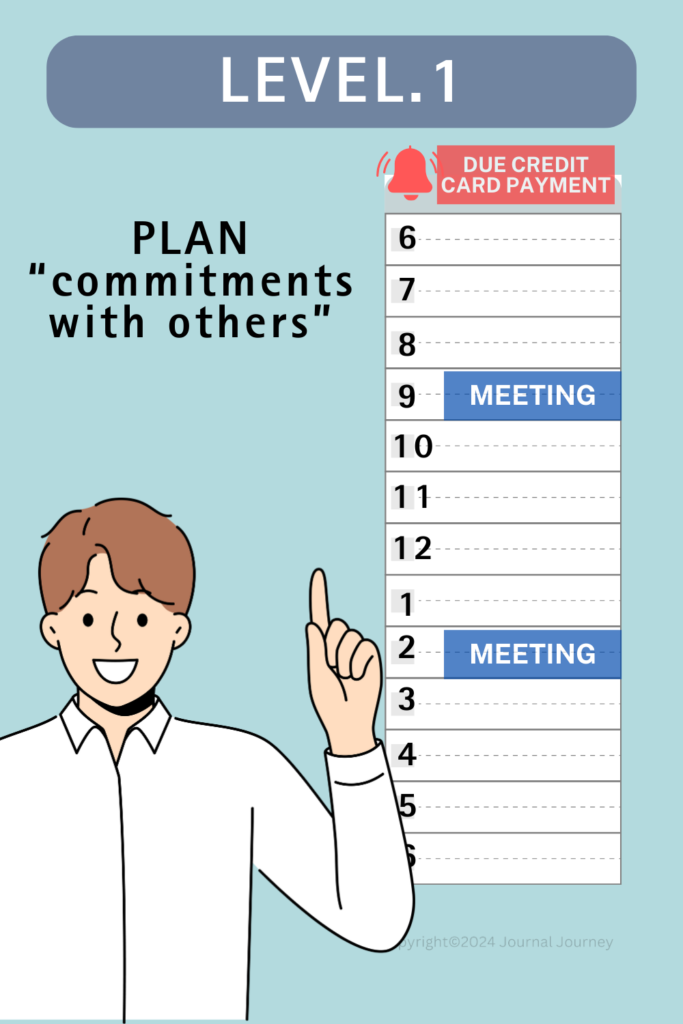
How-to
The method is to enter “future plans”. That’s it.
Which plans
So, which plans out of “future plans” should you enter?
Basically, “commitments with others” are good.
In other words, things that “if forgotten, will inconvenience others” or “if forgotten, could lower your trust.”
An example of “if forgotten, will inconvenience others” is a hair salon appointment. (The hairdresser is waiting for you, and if you don’t show up, their income decreases. The time they set aside for you becomes wasted unless a walk-in customer comes. It’s a loss for the salon.)
An example of “if forgotten, could lower your trust” is the payment deadline for credit cards or utilities. If you don’t pay by the due date, your credit score will drop. This also applies to promises with friends. If you miss a set date, you will be seen as someone who doesn’t keep promises, and your trust will be lost instantly.
Tutorial
Now let’s actually enter the plans.
Here is an example of a weekday.
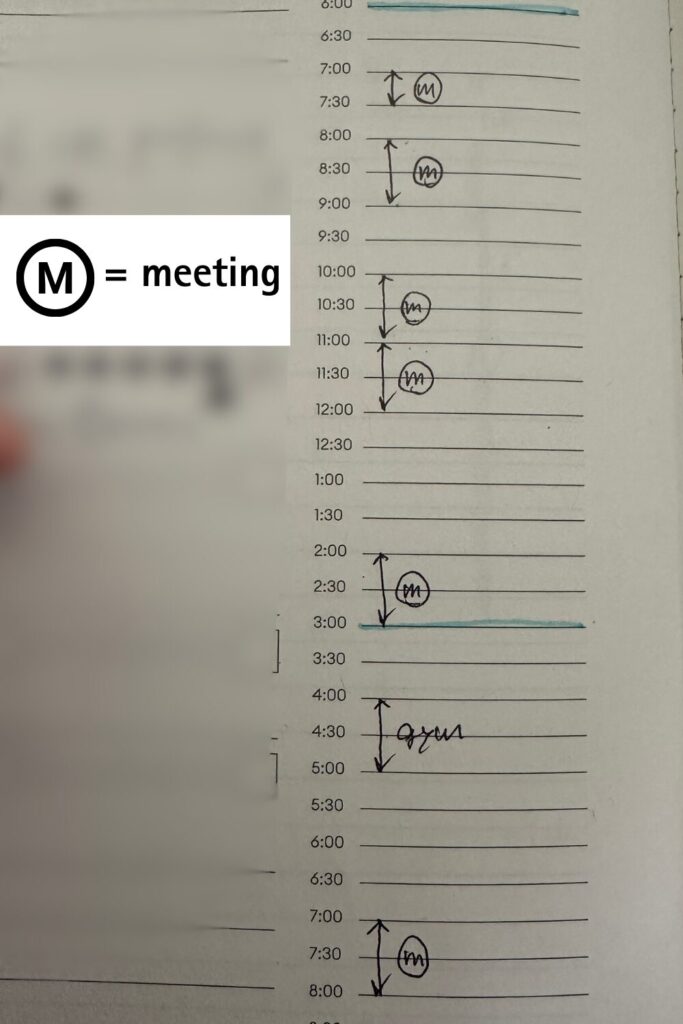
Now the plans are visualized, and it’s easier to grasp the flow of the day.
But that’s not all that’s visualized.
What other information can you see?
- There are a total of 5.5 hours of meetings.
- Excluding meetings, there are 4.5 hours of work time alone.
- 30 minutes for checking and responding to emails, 30 minutes for lunch, and 30 minutes for a coffee break after meetings. As a result, the actual work time for your project is about 3 hours.
- The actual work time is 3 hours, and those 3 hours are scattered. The longest slot is 2 hours from 12:00 to 2:00.
- From 3 PM when work ends to 9 PM when you go to bed, excluding gym (personal training) time and one global meeting, there are about 4 hours of free time. But with dinner and a bath, the actual time for personal activities is about 2 hours.
How is it? Just entering the plans for the day allows you to visualize the flow of the day, the total meeting time, the time you can concentrate alone, and the private time, making it easy to grasp the day.
And you might realize that time is surprisingly limited.
To use time effectively, I recommend trying Level 1 at least once.
This can also be easily done with Google Calendar or other commonly used calendars in companies.
My Experience
From my experience, I didn’t manage my work well. Why?
- I raised the priority of issues that arose in the previous meeting, and my planned project didn’t progress. Responding to urgent issues is not bad, but I didn’t have the time to reconsider if the unexpected issue was really urgent for me. As a result, I often worked on new issues that came up in the previous meeting. This delayed the deadlines for parts of the long-term project I was supposed to do today.
- Since it wasn’t clear when to do which of my tasks, I chose the “easiest task” among multiple tasks, resulting in wrong priorities. In other words, I did tasks that didn’t need to be done today.
Subscription Cancellation
Recently, various services are based on subscription contracts.
I also pay monthly subscription fees for Netflix and YouTube.
But when the service I tried didn’t meet my expectations, I cancel the subscription.
At that time, I worry if the cancellation was really successful.
I have experienced being charged for months after I thought I had canceled. Some were refunded, but I suffered a significant loss…
So, when I cancel, I always enter plans into Google Calendar to check if the cancellation was REALLY successful for the next two months.
Why two times? Because the withdrawal date and the actual cancellation date differ depending on the service, I double-check by confirming for the next two months.
Level 2 : “Plan with yourself”
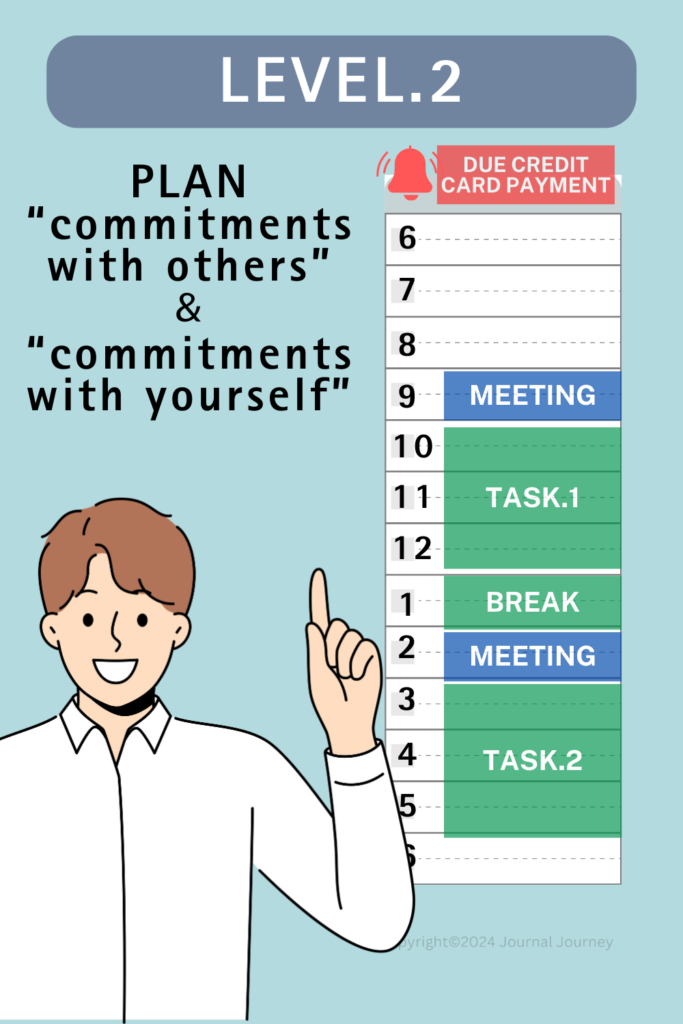
How-to
The method is to enter future plans. It’s the same as Level 1.
Which plans
So, which plans should you enter? Level 1 was basically “commitments with others,” but in Level 2, you also add “commitments with yourself.”
“Commitments with yourself” include projects or tasks you are committed to at work, or in private, it could be “dinner with family,” “reading,” “DIY,” or volunteer activities.
Tutorial
I also added my commitments like below.
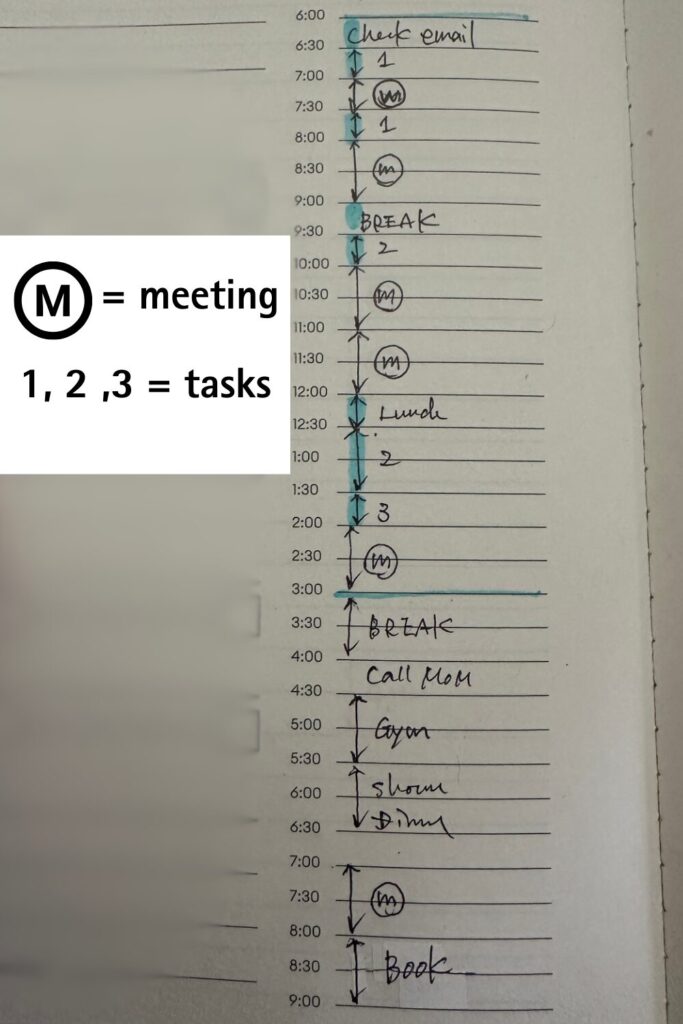
Now, not only are the plans visualized, but it is also clear when to do which task.
(1, 2, and 3 in the table are each high-priority tasks to be done alone)
(I highlighted my time during work in blue for clarity.)
What other information can you see now?
- At work, there are about 3 hours available for my tasks, and they are scattered.
- Task 1 and Task 2 cannot be done continuously, so concentration may decrease, and the output may not be as planned.
- There is not much private time. About 1 hour for reading.
How is it?
By adding “commitments with yourself” to “commitments with others,” the reality of available time increases significantly.
And you will strongly feel that time is surprisingly limited.
If you want to improve work performance and private productivity, I recommend trying Level 2.
This can also be done with digital tools like Google Calendar.
My Experience
In my case, stress was significantly reduced.
- Because, in my case, “commitments with myself” at work are often long-term projects, and daily small progress is important. Even if the goal is three months away, blocking time for high-priority progress on that day makes it clear and easy to be aware of.
As a result, when additional work requests come from others, it is easier to triage which is more important for me now. - The company calendar is shared, and if there is free time, others may mistakenly think “this person has free time” and add more meetings. Basically, we don’t have free time. By adding “commitments with yourself” to your calendar, you can minimize unnecessary meeting invitations.
Level 3 (Optional) : Reassess Plan
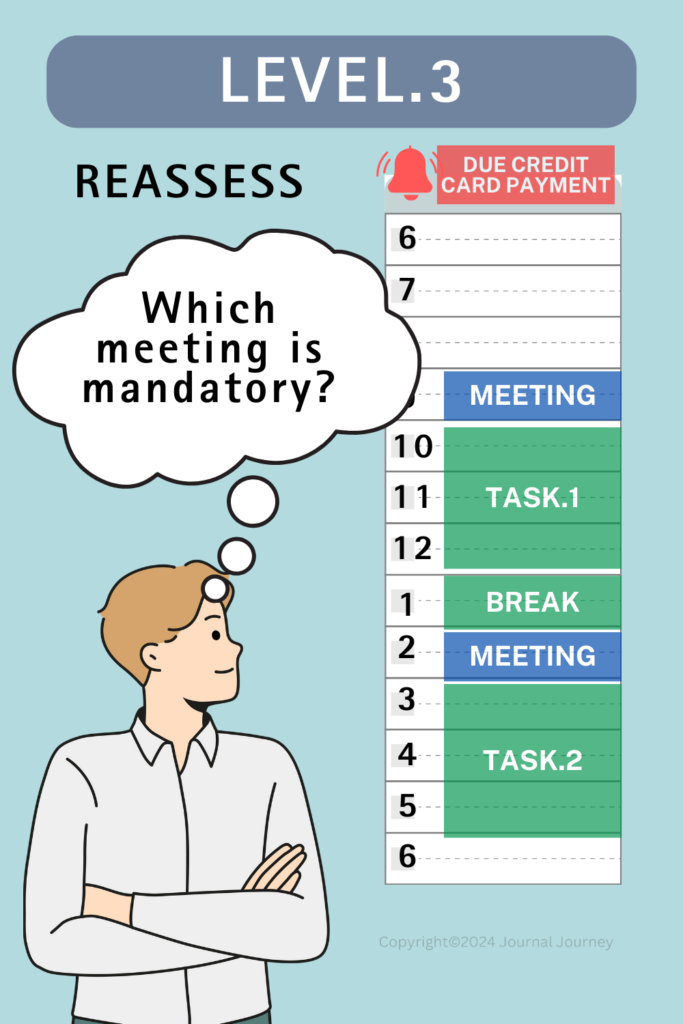
How-to & Which plans
Level 3 is the same method and plans as Level 2.
However, after Level 2, you add the task of “Reassessing.”
In other words, after entering future “commitments with others” and “commitments with yourself,” you reassess the need of those commitements.
Ultimately, you can maximize your time to perform high-high-prioity tasks.
This level is required only if you feel dissatisfied after Level 2.
That’s why I call it “optional.”
What to reassess
So what do you “reassess”?
The following two points:
- Reassess “commitments with others”
- Reassess “commitments with yourself”
“Reassess” means “determine if it is really necessary to allocate time, depending on your priority.”
Tutorial
Let’s reassess.
“Commitment with Others”
By reviewing “commitments with others”, you can reduce unnecessary commitments. As a result, you will have more time to focus on your projects.
For example, “gym with personal trainer” is probably necessary. Health is the most important factor in the life, so let’s keep it.
What about the meeting at 10 AM tomorrow? is it necessary for you?
If you are the facilitator of the meeting for your project, it is really necessary. However, if it is a meeting facilitated by someone else and you don’t need to share your opinion urgently or importantly, it is probably not necessary.
You can review the minutes later and follow up.
By keeping only truly necessary commitments, you can think and devise ways to increase the time available for your projects.
Really need that meeting?
The same applies when you are the facilitator of the meeting.
Before sending a meeting invitation, pause and think if it is really necessary to talk live using others’ time.
Can the discussion be done via email or group chat?
Sending a meeting invitation means taking others’ time.
Always examine the need of the meeting first.
“commitments with yourself.”
Next, reassess “commitments with yourself.”
The purpose is to secure as much “continuous time” as possible to focus on one task. If there is a meeting in between, concentration will be disrupted.
I hope to secure at least a minimum of 2 hours of slots.
For example, in the example below , Task 1 and Task 2 are scattered.
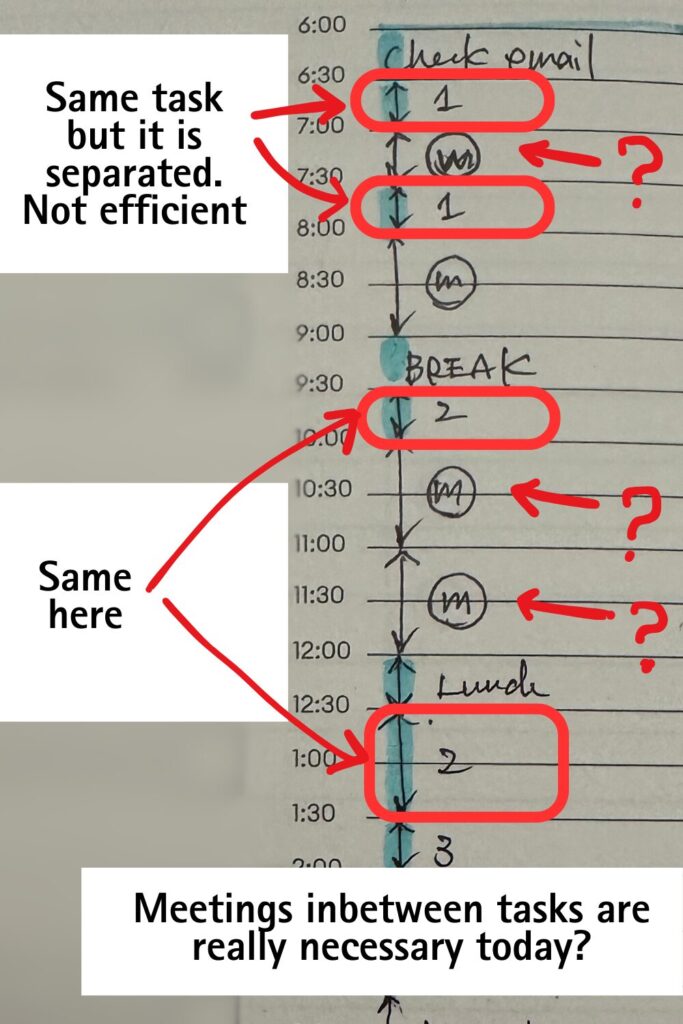
First, determine if the meeting between the two Task 1s is really necessary, and if not, use the continuous 1 hour for Task 1. The same applies to Task 2. Review the meeting from 10 AM to 12 PM and reassign the tasks.
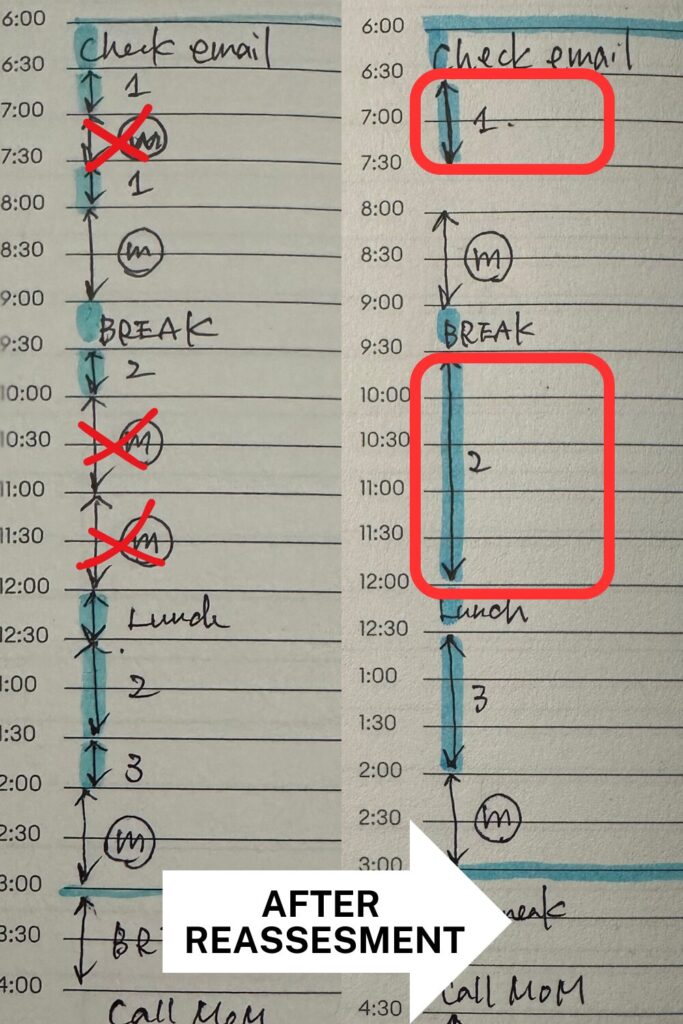
After Reassess, I got contagious hours for my project by removing 3 meetings.
My Experience
In my case, stress was further reduced.
By eliminating unnecessary meetings, I judged that half of the meetings were unnecessary. As a result, I was able to devote time to the projects I committed to.
Alex Hormozi & Michael Hyatt’s ideas
Various business professionals propose how to plan your day effectively.
Recently I encountered these 2 below resources, which I thought it’s interesting.
Alex Hormozi talks about planning a week into Makers Time and Managers Time to increase productivity.
Also, Michael Hyatt’s “Ideal Week” planner method proposes increasing productivity by grouping similar tasks
How to Better Control Your Time by Designing Your Ideal Week
Level 4 : Plan & Record

Finally, Level 4.
How-to & Which plans
Level 4 involves the same methods and plans as Levels 2 and 3.
This is based on Levels 1, 2, and 3, with the additional task of “recording.”
Levels 1, 2, and 3 involve “planning” the day either the night before or on the day itself, but Level 4 involves “recording” during the execution of the day.
When both “planning” and “recording” are combined,
you can identify your true productivity as well as many issues that you could enhance.
Let’s look at this step by step.
What to record
What do you “record”?
When you execute the day according to the plan, you record the results of actual time usage on the right side of the timetable.
Tutorial
This is how it looks.
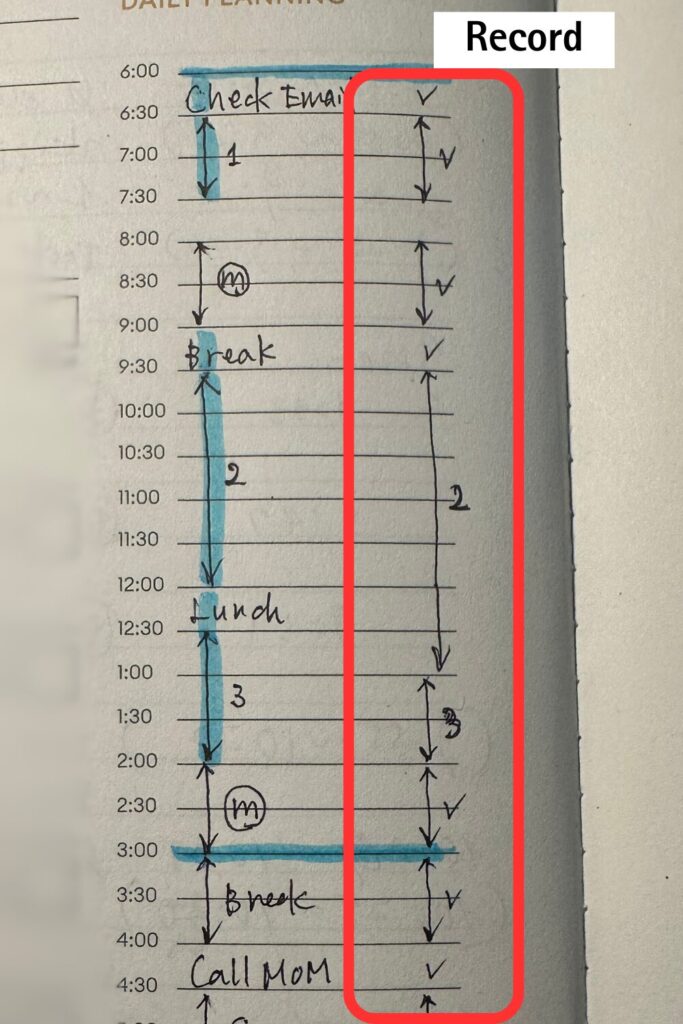
This way, the left side is “planning” and the right side is “recording,” making it easy to see how well/bad you executed the plan.
Why Record?
So Why do you “record”?
The record is your activity log.
It tells you much more information about you than you believe.
Let me cover the 3 reasons
Reason 1: Find good points and areas for improvement
By comparing “plans” and “records”, areas of good productivity and areas for improvement can be identified.
For example,
If Task 1 proceeded as planned, it means your time estimation for the task was accurate, and you can see that your time estimation ability for that task was correct.
If Task 2 did not proceed as planned, that would be the for improvement
Reason 2: Find strategies for improvement
Task 2 did not complete as planned, then various reasons can be considered.
When you see the gap between “plan” and “record”, those are the areas you can deep dive WHY as part of daily/weekly reflection.
First, reflect on that timing and consider possible reasons of why Task 2 did not get completed.
for instance, it could be…
- Your boss asked for an urgent task, lowering the priority.
- The previous meeting ran over, leaving only 1 hour of the planned 2 hours.
- You felt mentally down after the previous meeting, affecting your concentration.
- The time estimation was wrong, and the planned 2 hours were not enough.
- A colleague chatted with you, taking up time.
- You felt sleepy after lunch.
Next, observe the possible reasons more deeply.
For example, if you underestimated the time required for the task,
then ask yourself why you underestimated?
- It was your first time doing the task, so you had no idea how long it would take.
- It wasn’t your first time, but there were always different exceptional tasks within it, taking up time.
- It wasn’t your first time, but you got sidetracked and fell into a rabbit hole. (You were heading towards Goal A, but a question B arose, and you spent a lot of time solving it, etc.)
By observing and finding the cause like above, you can take measures to avoid repeating the same mistake. That is the next action.
For instance,
- If it was your first time doing the task and you had no idea how long it would take, next time, instead of “doing it for 2 hours,” try “doing it for 1 hour to get a rough idea of the task size.” “Doing it for 2 hours and completing XX but not knowing what percentage of the whole is done” is less productive than “doing it for 1 hour to understand the overall task size.”
- If your boss asked for an urgent task, next time, when your boss asks for an urgent task, you can confirm, “Is this urgent task more important than Task 2?” You might find that Task 2 is more important to your boss.
- If a colleague chatted with you, next time, switch your chat to ‘do not disturb’ or log off during focused tasks.
- If you felt mentally down after the previous meeting, take a 30-minute coffee break, go for a walk, do simple tasks that don’t require concentration, or clean your desk to refresh yourself.
How is it? By identifying the discrepancies between planning and recording, you can find your strengths and areas for improvement. If you find areas for improvement, you can plan better tomorrow than today.
Purpose 3: Visualize your Prime hour and day
By continuing for a while, your behavior patterns become apparent, allowing you to plan more suited to yourself.
(Refer to this article to find your peak times.)
You might find that your highest performance is on Monday and Tuesday mornings, or that your concentration drops on Friday afternoons. Continue for at least two weeks to understand when your performance is best and worst, and plan important tasks accordingly. (Circadian rhythms suggest that 11 AM and 3 PM are the highest performance times.)
My Experience
For me, this is the best.
I always use an analog planner, quickly filling in the Hourly Table and reviewing it on weekends.
This recorded information is very useful for Daily and Weekly Reviews. Understanding when I am most productive helps me form hypotheses to improve performance.
Conclusion
Every time you look at the Time Schedule Table, you will be reminded of how limited your time is. There are infinite things you want to do in both work and private life, but time is finite. Doing only the necessary tasks is key. Try the method that suits your pace from Level 1 to Level 4.
Resources
You can check other contents for your productivity enhancement.





